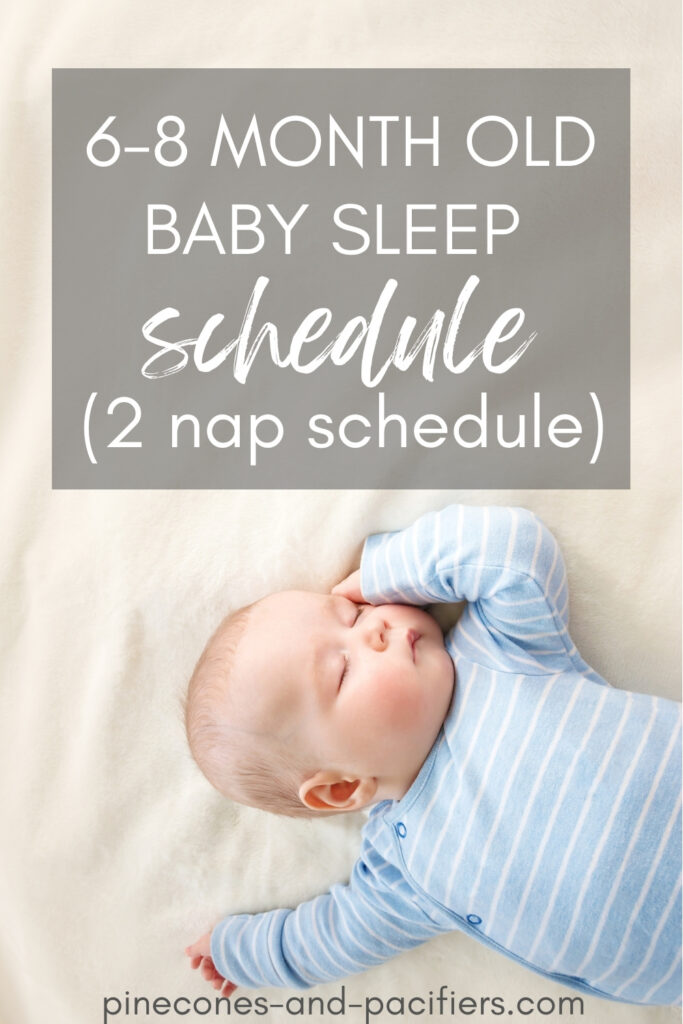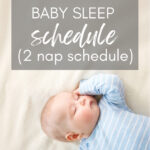An easy 6 month old schedule for feeding, naps, and sleep. Follow this eat-wake-sleep routine with 2 naps to help your 6 month old sleep better!
Need help with a schedule or wondering how many naps they should take at 6 months old? I’m a mom of two and sharing our 6 month old schedule that has worked well for both of my boys.
Just starting out? If you are just starting out with a schedule, I recommend reading my 2 month old schedule post. This can help you out with how to get your baby started on a schedule. Check it out here >> 2 Month Old Schedule (How To Start A Baby Schedule)
Its normal for babies to take 2-3 naps around 6 months old. If they are not at 2 naps already, its also a common time for them to transition to 2 naps per day.
As babies get older many are able to stay awake for longer periods of time in between naps and consolidate their naps into a few longer naps per day. This has been true for both of my kids!
If you want to check out some of our schedules for younger or older babies, check out these other posts in my scheduling series:
- 2 Month Old Schedule (4 naps)
- 4 Month Old Schedule (3 naps)
- 8-10 Month Old Schedule
- 1 Year Old Schedule
- Ultimate 1 Nap Schedule
- Newborn & Toddler Schedule
- 18 Month Toddler Schedule
Parent Directed Schedule
We loosely follow a parent directed feeding and sleeping schedule, like the one discussed in the book Becoming Babywise. I highly recommend that all soon-to-be or new mamas read this book to save their sanity in the newborn phase!
Nearly everyone thrives on routines. Even if you don’t realize it, you likely feel the best when you wake up at a similar time each day, eat at regular intervals, and go to bed at a decent hour. Babies are very similar!
Parent directed schedule means that the parent offers some guidance for a daily schedule that follows baby’s cues. If your baby is hungry, feed them! If they are extremely sleepy, put them to bed. For young babies it is important that you have a schedule as a guideline, but listen to your baby and meet their needs.
My biggest takeaway for parent directed scheduling is that you set an age-appropriate schedule. This will help ensure you aren’t trying to force something on your baby that they just won’t be able to do or that is unnatural.
You may even find that many babies will naturally fall into a routine themselves!
Sleep Environment
If you feel comfortable with it, 6 months old is a good age to transition your baby to their own room for naps and night time. We started all of our babies in their own rooms from day one, but many parents wait a little longer. Here are some items you will want in your baby’s room to promote safe and restorative sleep:
Delta Children Essex 4-in-1 Convertible Baby Crib: A crib is the safest place for your baby to sleep. Keep the crib clear of any blankets or toys and always place your baby in alone, on their back, on a firm mattress.

Burt’s Bees Baby Sleepsack: loose blankets can be s suffocation risk for babies and young toddlers. A sleep sack is a great option to keep your baby warm, while still practicing safe sleep. It’s also a great transition from a swaddle, which becomes unsafe once your baby can roll over. It can also keep your toddler from climbing out of their crib when they get older. We also use and LOVE the Zipadee Zip Swaddle Transition

Hatch Rest+ Baby Sound Machine: a sound machine can help soothe your baby and drown out the noise from outside their room. The Hatch plays white noise along with a variety of other relaxing sounds. It also acts as a night-light and okay to wake clock that you can utilize when your baby gets a little older.
Eat Wake Sleep
Many parent directed schedules follow the eat-wake-sleep routine. This means that first your baby eats, then has some awake time, and then goes to sleep.
The key point is that it separates eating from sleeping to teach your baby not to associate sleeping with eating; they won’t need to eat or nurse in order to fall asleep. It also ensures that your baby is well-rested before eating and will take a nice full feed; they won’t fall asleep half way and only get a snack.
Starting Drowsy But Awake
Another key feature of the Babywise method is teaching your baby to fall asleep independently. This ensures that if they wake up in the middle of their nap or the middle of the night, they will be able to put themselves back to sleep and not rely on you to fall back asleep.
If you currently nurse, feed, or rock your baby to sleep, help build independent sleep skills by putting your baby down to sleep when they are drowsy, but not yet asleep. When you first start, your baby will be very close to sleep when you lay them down. As you practice this method, try setting your baby down when they are less and less drowsy.
This may take many days or weeks, but eventually you will be able to lie your baby down wide awake and have them fall asleep without any assistance from you (the end goal!). We normally start drowsy but awake at just a few weeks old, but if you haven’t started yet its never too late!
Sleep Details
Daily Sleep Needs: At 6 months old, most babies need about 14-15 hours of sleep per day. For us this means naps totaling about 3 hours and about 12 hours overnight.
Naps: A good restorative nap is normally 1 hour or longer so you want to shoot for long naps in your schedule. At 6 months most babies take 2-3 naps per day. Both of mine have done great with 2 longer naps at this age. If your baby takes short naps, it may be developmental, or you may want to try to teach them how to fall asleep independently using the drowsy but awake method mentioned above.
Overnight Sleep: Unless there are medical concerns, most babies can sleep 10-12 hours overnight at 6 months old (sometimes waking for a feed). Both of my babies started sleeping 11-12 hours around 4 months old (you can check out that schedule here).
Wake Time: Most 6 month olds should be awake for 2.5-3 hours in between nap, and slightly longer before bed (3-4 hours). Both of my boys have done good with 2.5 hours before their first nap, 3 hours before their second nap, and 3.5 hours before bed; this is sometimes called the 2.5/3/3.5 hours schedule. If your baby is staying awake any longer than this during the day, it is likely that they will become overtired and be harder to get to sleep or have trouble staying asleep.
How To Drop A Nap?
If your baby is currently on 3 or 4 naps, you may be wondering how to get to this two nap schedule.
What are the signs? There are a couple of common signs that your baby is ready to drop to two naps (or drop a nap in general):
- Fighting their last nap of the day
- Taking a long time to fall asleep for naps or bed
- Waking up early from naps
- Waking up early in the morning
This is not to say that all these signs mean you need to drop a nap, or that you baby must be displaying all these in order to drop a nap, but its a good guideline!
How do you do it? Because there are only so many hours in a day, to drop a nap you will need to extend the amount of time your baby is up in between naps.
For example, if they are normally awake for 2 hours in between naps and taking 3 naps per day, try extending their wake time by 10 mins every few days until the last nap become too late and they skip it all together.
You may have to do an early bedtime at first. It sounds counterintuitive, but don’t fear early bedtimes! During this transition my son went from sleeping 11 hours at night to sleeping 12.5-13 during the time he had an early bedtime. It does not necessarily mean they will wake up extremely early in the morning.
6 Month Old Schedule
Below is our 6 month old schedule including naps and feeding times.
My baby has been on a loose schedule since he was about 2 months old so he has settled into this routine and loves the structure. But, as mentioned above we don’t force anything and do follow his cues with feeding. He currently takes about 6–8oz per feeding and does not eat overnight.
- 7:30 am Wake Up, Bottle ?
- 8:30 am Breakfast ?
- 10:00–11:00 am Nap 1 ?
- 11:30 am Bottle ?
- 12:30 Lunch ?
- 2:00–4:00 pm Nap 2 ?
- 4:00 pm Bottle ?
- 5:30 pm Dinner ?
- 7:00 pm Bottle ?
- 7:30 pm Bedtime ?
Since we do this same loose schedule everyday I also love to write out a block schedule so that I stay on track with other parts of my day as a stay at home mom, and can also keep my toddler on schedule. (You can check out my toddler schedule here).
I have been LOVING this block scheduler recently!
Schedule Magic Weekly Block Schedule
If you want to check out some of our schedules for younger or older babies, check out these other posts in my scheduling series:
- 2 Month Old Schedule (4 naps)
- 4 Month Old Schedule (3 naps)
- 8-10 Month Old Schedule
- 1 Year Old Schedule
- Ultimate 1 Nap Schedule
- Newborn & Toddler Schedule
- 18 Month Toddler Schedule
Thanks for stopping by!

